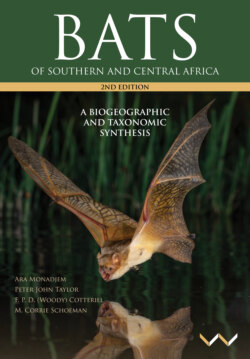Читать книгу Bats of Southern and Central Africa - Ara Monadjem - Страница 44
На сайте Литреса книга снята с продажи.
ECHOLOCATION SYSTEMS
ОглавлениеTwo different echolocation systems – high and low duty-cycle echolocation – evolved independently in the Chiroptera (Eick et al. 2005). Low duty-cycle echolocation bats emit narrowband or broadband sound pulses separated by inter-pulse intervals that are much longer than the duration of the emitted pulses. Such species therefore separate the emitted pulse from the returning echo in time (Fenton 1990).
High duty-cycle bats emit long, narrowband pulses that are separated by much shorter inter-pulse intervals. Consequently, the emitted signals often overlap with the returning echo. However, the overlap does not produce masking effects (Schnitzler and Kalko 2001), because Doppler-shift compensation keeps the target echo in the range of the neurons of the acoustic fovea – a group of neurons sharply tuned to a very narrow frequency band, a few kHz higher than the peak frequency of the emitted signal (Neuweiler 1990). The Doppler effect is the change in frequency of a sound wave as perceived by a listener moving relative to the source of the sound. For example, the frequency of the siren of a passing emergency vehicle will start out high, slide down as it passes by the listener, and continue lower as it recedes into the distance. In other words, high duty-cycle bats separate the emitted pulse from the returning echo in frequency rather than time (Fenton 1990).
